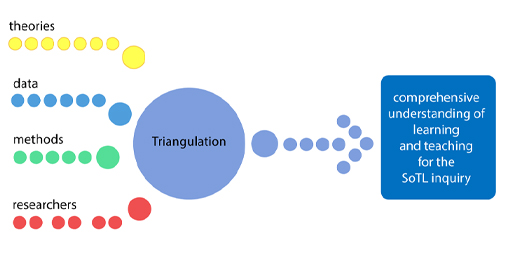2.2.3 Triangulation
Triangulation refers to studying a specific issue from more than one standpoint (alternative perspectives) by combining different research approaches, methods or sources of data within a single research project.
It is important to note that triangulation does not necessarily mean that the researcher is using three (as in tri-) sources of data; it simply means that there is more than one source of data. Ultimately, this enables the researcher to try to get a better handle on what is happening in reality and to have greater confidence in research findings (Glesne, 2006 in Mertler, 2017).
Triangulation is a commonly used technique to strengthen research findings and to provide richer or more robust and authoritative knowledge.
To some authors, triangulation is synonymous with the use of mixed methods for data collection (e.g. Burns, 2000). A mixed methods approach can achieve triangulation by combining data from two different methodologies – qualitative and quantitative – and through the use of multiple research methods such as quantitative surveys, observations, document analysis and follow-up interviews. The sets of data would then be combined, creating a situation where ‘having a cumulative view of data drawn from different contexts, we may, as in trigonometry, be able to triangulate the “true” state of affairs by examining where the data intersects’ (Silverman, 2000, p. 98).
In addition to triangulation of methods, three other types of triangulation have been identified by Denzin (1978) and Patton (1999):
- triangulation of data; for example, over different points in time, or collected from people with divergent views, or in different settings.
- triangulation of investigator, whereby multiple researchers are involved in a study, thereby mitigating bias and increasing the range of perspectives involved in interpreting the collected data.
- triangulation of theory, whereby multiple theories are used within the analysis stage of a research study. The advantages of theory triangulation are, according to Denzin, that it prevents researchers from sticking to their preliminary assumptions and from ignoring alternative explanations.
Denzin (1978) sees triangulation as a strategy for a deeper understanding of an issue under study and thus as a step towards more knowledge, and less towards validity and objectivity in interpretation. Triangulation is also not conceived of as a strategy for confirming findings from one approach by findings from using another approach. Rather, triangulation aims at broader, deeper, more comprehensive understanding of what is studied – and that often includes, or heads at, discrepancies and contradictions in the findings (Flick, 2018).
In practice, resource, time and budget constraints are likely to dictate the degree of triangulation that can be achieved in any research. You should therefore aim to achieve a degree of triangulation for your project but only to the extent that it does not create an unmanageable degree of risk to the project as a whole.

